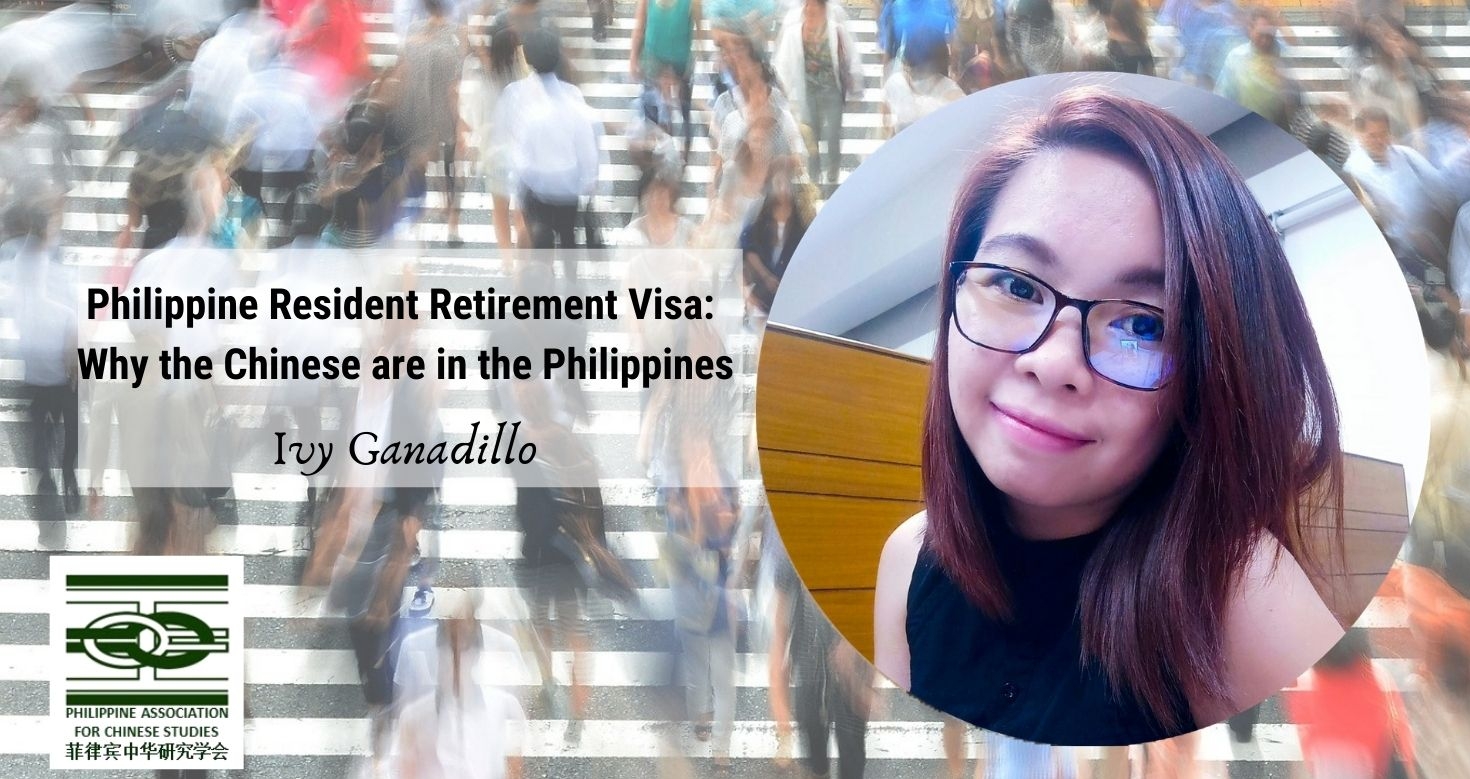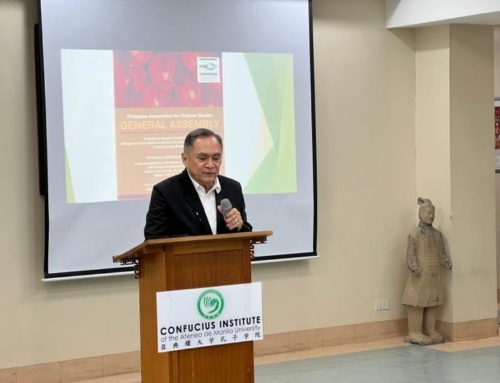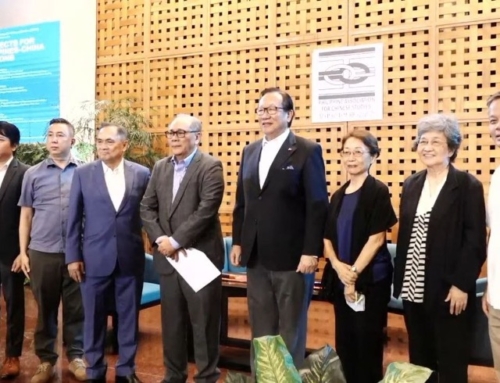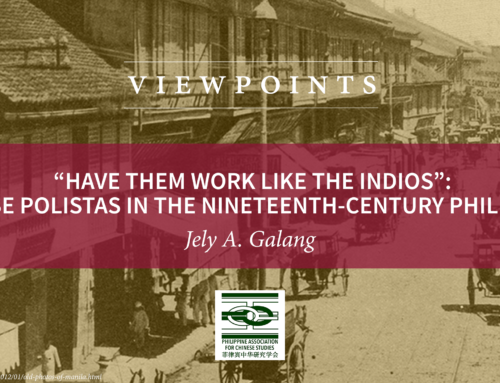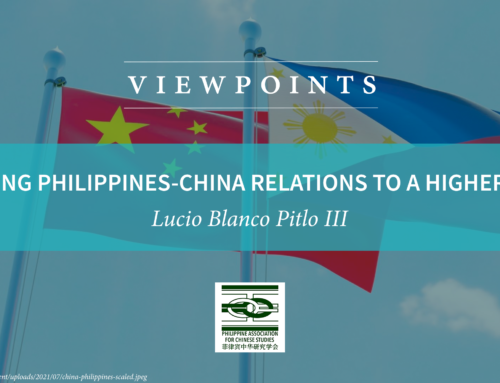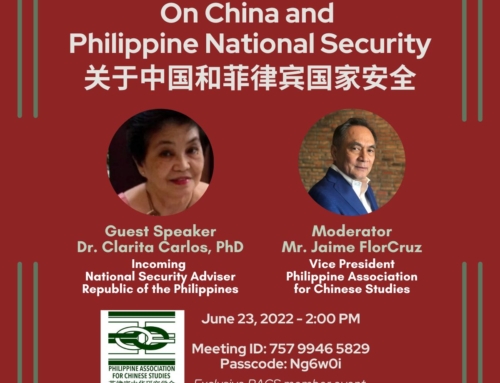By Ivy Ganadillo
Nov. 11, 2020- Just as news emerged on the huge number of Chinese retirees in the Philippines through the Philippine Retirement Authority’s (PRA) Special Resident Retirement Visa (SRRV), I started reading again netizens describing the presence in the country of the Chinese with words such as “economic competition”, “communists”, “invasion”, etc. These are also common comments on the Philippine Offshore Gaming Operations (POGOs) with Chinese employees.
During the Department of Tourism’s budget hearing, Senator Richard Gordon expressed his astonishment at the PRA’s retirement policies and asserted that a huge number of Chinese in the country is a “national security concern”.[1] Other senators also conveyed their worries on the capability of the agency to monitor the activities of the foreign retirees. Drawing from the past research I did on the New Chinese migration in the Philippines[2], I was more surprised to hear the reactions of the senators and their ignorance on the legality of the presence of these Chinese retirees based on the PRA policies. It is also dismaying how the Chinese SRRV holders are instantly singled out among other nationalities, and how their privileges and benefits as multiple entry visa holders are said to be “dangerous”. As the influx of Chinese retirees has been seen to be alarming by some Senators, it pressured the PRA to suspend and amend the issuance of SRRV.[3]
The Chinese Migration to the Philippines
Historically, Chinese migration to the Philippines is not a new trend. The ethnic Chinese population in the Philippines is a product of old Chinese migration with migrants mostly hailing from Fujian Province in China. Studies on Chinese migration have highlighted an array of reasons why the Chinese, from the early 15th century until the takeover of the Communist Party in 1949, came to the Philippines and the most common drivers of migration being economic factors.
The migration of the Chinese to different countries from 1978, the year when China adopted an Open-Door Policy, led to the phenomenon of the “New Chinese Migrants” (NCMs). Unlike earlier migration patterns, Chinese migrants in the Philippines are not only from the poor provinces but also the national capital, from the rich cities, and the fast-developing regions of China. They are tourists, students, professionals, laborers, and missionaries, among others.
According to the Philippine Bureau of Immigration (BI) Annual Immigrant and Non-Immigrant Visa Report, Chinese nationals make up the largest migrant group in the Philippines – 25% of the foreign nationals with additional 1,000 registered student visa holders as of December 2014. The BI Press Releases[4] of January to October 2020 show that a number of Chinese citizens were included in recent deportations who reportedly violated the Visa Upon Arrival (VUA) conditions or who exceeded their allotted stay in the country. Other reports include Chinese illegal workers in online gambling and mining companies. In 2019, the BI said it has barred more than 7,700 unwanted aliens from entering the country – the highest in the agency’s history.[5] It was disclosed that 3,527 of these are Chinese, the biggest group on the list of the excluded aliens. These foreigners were found to be improperly documented, or ineligible to enter and stay in the Philippines after inspections.
New Chinese Migrants (NCMs) and the Chinese SRRV holders in the Philippines
The Philippine Retirement Authority is a government-owned and controlled corporation created by Executive Order No. 1037, signed in 1985. It is an agency under the Department of Tourism (DOT) that manages the Special Resident Retiree’s Visa. Its vision is to make the Philippines a leading destination of the world’s retirees and at the same time to contribute to socio-economic development and strengthen the country’s foreign currency reserves. The SRRV is a special non-immigrant visa that entitles foreign nationals and natural-born Filipino citizens to reside in the Philippines indefinitely with multiple-entry privileges. This kind of visa has become one of the attractions for Chinese migration to the Philippines.
During the recent DOT budget hearing, the data presented shows that the Chinese comprise the highest number of foreign retirees in the Philippines, with over 27,000, followed by Koreans at 14,000, and Indians at 6,000. [6] From the last data I requested from PRA in 2015, as of 31 December 2014, the mainland Chinese comprised 41% of SRRV enrollment (11,327 out of the 27,815 retirees). From 1987 to 2014, if we include the principal holders as well as their dependents, the Chinese mainlanders were the top holders of SRRV in this long period. SRRV dependents include the spouses and children who are 34 years old and below. They have the greatest number of dependents, compared with other nationalities, and usually have one or more dependents who live with them in the Philippines.
For all nationalities, PRA principal retirees (upon the time of enrollment) classified by age bracket were mostly from 50 to 64 years old, followed by 40 to 49 years old and 35-39 years old. However, according to the 2015 PRA data, 80% of the Chinese principal retirees are within the age bracket of 35 to 49 years old. In addition, 90% of Chinese SRRV holders came from Fujian province, 75% established their businesses, and most of them stayed in Binondo, the Chinatown area. The trend of Chinese enrollment to the PRA retirement packages from 1987 to present has continued to grow.
What attracts the foreigners to avail of the retirement program?
Since 1988, the SRRV has been one of the measures undertaken by the Bureau of Immigration’s Amnesty Program to regularize and provide permanent residency to illegal and overstaying migrants in the Philippines. Its policies eventually developed and focused not only on retirement but also on investment and lifestyle. It expanded the coverage to attract the active group who are eligible to retire at the early minimum age of 35.
SRRV retirees have different options that they could avail of, depending on their age and primarily what they could afford.[7] There are different packages and the lowest maintaining bank deposit is US$20,000.00 in any of the PRA accredited banks. There are also packages where they can opt to have an active investment such as the purchase of a condominium unit or long-term lease of a house & lot. So, small wonder that there is a real estate boom in the Philippines with the Chinese as one of the main clientele. [8]
Under the SRRV, the PRA also grants important benefits to the retirees. Some of the most important ones are special, non-immigrant status with multiple entry privileges; one-time exemption from customs duties and taxes of personal and household goods; exemption from the BI Alien Certificate Registration Identification Card (ACR I-Card); pension and annuities remitted to the Philippines are tax-free; exemptions from securing the Student’s Visa/Study permit; and free assistance in securing documents from other government agencies.
The PRA holds an annual promotional campaign in China with the support of the DOT office in Shanghai. The institution promotes the Philippines to foreign nationals as their choice for a second home. The PRA banners the Philippines’ vibrant culture, hospitality, friendly English-speaking population, natural attractions, and tropical climate, in which retirees can expect a good life in the Philippines at an affordable cost. It also showcases the Philippines’ world-class medical and health services. It promotes the country’s healthcare facilities, medical personnel, caregivers, and the Filipinos as world-renowned excellent healthcare practitioners. Merchant partners are available for a wide range of service areas including consultancy, health clinics, education, recreation, legal, hotels, real estate, shopping, and travel and tours.
Why the Chinese choose the Philippines
I documented personal narratives of some NCMs in the Philippines, and as evident also from the reports of government agencies, they come from diverse backgrounds. There are a number of NCMs who moved with their entire family. They became part of the Philippine working professionals and students. There are those who are capable of investing their money in the country. There is also a small percentage of new migrants that are undocumented and who may be involved in illegal activities.
I summarized their motivations for moving to the Philippines as follows: (1) to explore possible economic opportunities; (2) to obtain personal, professional, and career growth and development; (3) to escape from social and academic pressures; (4) to have a better physical environment; (5) to enjoy religious freedom; (6) and to be reunited with family or relatives. On their decisions to stay in the Philippines, their reasons include (1) opportunities of making personal choices and decisions against the pressure of traditional norms and culture and government intervention; (2) a sense of belonging with the ethnic communities and people with the same values and beliefs; (3) ease of adaptation to the society’s culture and norms; (4) comfort of living in the new physical environment; (5) and access to health and education facilities.
Questions on Philippine Migration Policies
Our country has been a point of departure as well as a destination for migration but the gap is present, especially in our policies on receiving international migrants. In light of the recent public discussion about the retirees’ visa, let me ask some questions. How should we, Filipinos, approach the influx of other nationalities in our country? Should we discourage or limit their migration? What are the grounds? Should we have a quota? What should be done? Is there a national security threat?
Looking at the data, the danger or threat may come from those who violate their visa conditions, and those engaged in illicit activities. This poses significant challenges to the Philippine government and the two countries’ relations. The Philippines should continue strengthening its cooperation on immigration policies and mechanisms for monitoring and preventing the recurring flow of illegal migrants and illegal activities especially those that create tensions in the local economy and industries. Continuous cultural and people-to-people exchange should also be encouraged to lessen the negative stereotyping between the nationals of the two countries.
For those in authority who serve as the highest decision-makers of our country, I hope that they would not easily dismiss the fact that what we are reaping today are products of what we have sowed in the past. These visa policies encouraged those who are qualified to acquire it. The rules are simply being followed. Whether the age 35 threshold for retirement is too low or has other implications deserves a review. If there are policy lapses, this should not be blamed on those who are qualified and followed proper procedures. I agree that the national security and the interests of our country must always come first. Thus, the situations and factors that may endanger these should be carefully thought of, studied, planned, and solved. On the other hand, PRA has been continuously contributing to the country’s supply of foreign currency and also has a positive multiplier effect on its private partners. As the Philippines’ retirement packages attract more foreign nationals, the current policies are worth evaluating to make it more competitive and beneficial to the Philippines.
[1] https://newsinfo.inquirer.net/1350548/young-chinese-retirees-alarm-senators
[2] Ganadillo, Ivy Marie L. (2016). New Chinese Migrants in the Philippines: Exploring Non-Economic Factors in Migration Decisions based on Personal Narratives. Graduate thesis. University of the Philippines-Diliman
[3] https://www.pna.gov.ph/articles/1119539
[4] https://immigration.gov.ph/news/press-release
[5] https://immigration.gov.ph/images/News/2020_Yr/01_Jan/2020Jan16_Press.pdf
[6] https://www.cnn.ph/news/2020/10/20/Chinese-young-retirees-Philippine-Retirement-Authority0.html
[7] https://pra.gov.ph/srrv/
[8] https://business.inquirer.net/271305/china-bets-big-on-ph-property
